Natural Compound Improves Apple’s Red Color
Misting a natural compound, derived from plant oils, onto apples before or after they’re picked from the tree may improve their red color. That’s according to ARS studies with methyl jasmonate, an aromatic extract from plants such as jasmine and honeysuckle. Experiments by scientists at the Tree Fruit Research Laboratory, Wenatchee, Wash., indicate that methyl jasmonate increases the total percent of attractive, uniformly red color of Fuji, Gala, and Red Delicious apples. Though expensive, the compound is already classified as “Generally Recognized as Safe” by the Food and Drug Administration. Too, methyl jasmonate doesn’t change apple taste or texture. Field applications stimulate production of red anthocyanin pigments. Postharvest applications break down the peel’s green pigment, chlorophyll, boosting the visibility of the red pigments. In new studies, the researchers will determine the best formula and perfect time to apply the flower-scented chemical. The scientists are seeking a patent for their discoveries. For more information, contact James P. Mattheis, (509) 664-2280, ext. 249, USDA-ARS Tree Fruit Research Laboratory, Wenatchee, WA. New Vaccine Fights Salmonella in Poultry
Hens inoculated with a new, ARS-developed vaccine are less likely to transmit Salmonellaenteritidis into their eggs. This reduces the chance that people who eat raw or undercooked eggs would contract salmonellosis, typified by nausea, vomiting and severe diarrhea. Raw cookie dough or homemade mayonnaise or hollandaise sauce can contain raw eggs. ARS scientists also found that inoculated hens shed 10 to 40 percent less S.enteritidis in their feces. Less shedding helps reduce the spread of the infection through flocks. For these tests, researchers at the ARS Southeast Poultry Research Laboratory twice-inoculated hens with the experimental vaccine and then exposed the animals to the disease organism. ARS is seeking a patent for the experimental vaccine. The invention is more effective than current commercial vaccines because it boosts levels of antibodies that hens produce, in their intestines, to fight infection. Approximately 25 million doses of S. enteritidis vaccine are used each year by U.S. poultry producers. For more information, contact Peter S. Holt, (706) 546-3442, Southeast Poultry Research Laboratory, Athens, GA. Put America’s Premier Nutrient Database on Your Computer!A user-friendly version of the authoritative USDA National Nutrient Database is available for download onto your personal computer and laptop. That’s thanks to work by ARS scientists at the Beltsville (Md.) Human Nutrition Research Center, and their corporate colleagues at HealtheTech, Golden, Colo. The free, easy-to-search database designated as "Release 16" or "SR16" for short, lists up to 125 nutrients for more than 6,000 food items. Once the database has been downloaded to a computer’s hard drive, the user no longer has to go online to access it. The database requires about 70 megabytes of disk space on the hard drive. It runs on Windows 98, Windows ME, Windows 2000, and Windows XP. A “portion modifier” is among the handy features. After clicking on “carrots, raw,” for example, users can choose from a variety of standard portion sizes, or can increase or decrease the amounts to suit their needs. The search term “not” is also featured. That allows users to screen out unwanted foods by designating, for instance, “carrots, not raw.” The PC-download option is the latest in a series of developments to significantly expand the accessibility of the nutrient database. Earlier, the scientists collaborated in making the database available online, then packaged it for use on personal digital assistants (PDAs). For more information, contact Joanne M. Holden, (301) 504-0630, USDA-ARS Beltsville Human Nutrition Research Center, Beltsville, MD. Tactics Target Pantry Pest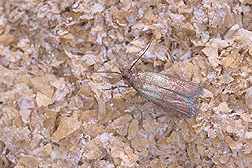
A tiny insect you may have seen fluttering from your kitchen cupboard, the indianmeal moth, is the target of diverse, innovative research by ARS scientists at the Center for Medical, Agricultural and Veterinary Entomology, Gainesville, Fla. The silvery, wedge-shaped moth is generally regarded as the most prevalent and damaging pest of food, feed, and seed stored in warehouses, retail stores, and homes. The scientists are seeking effective options that would reduce or eliminate use of conventional pesticides where commodities are stored. Their focus? Develop defensive strategies that exploit the moth’s own behavior and growth. For example, applying the moth's own hormones on warehouse walls and the outsides of food cartons can thwart the moth’s normal development and reproduction and prevent damage to stored cereal products. What’s more, preliminary studies of the male and female moths’ differing uses of daylight and darkness are revealing clues about undermining moths’ mating and egg-laying in warehouses. Changing the cycle of light and dark in warehouses, or perhaps switching to light fixtures that emit different wavelengths, may snafu infestations. For more information, contact Don L. Silhacek, (352) 374-5758, USDA-ARS Center for Medical, Agricultural and Veterinary Entomology, Gainesville, FL. Apache--An Early Apricot From ARS Treefruit Breeders
A delicious apricot named Apache is bound to be a hit--especially with people who’ve waited all winter for the taste of a tree-ripened apricot. Ready to harvest in the first week of May, Apache has a sweet, delicate flavor and pleasing aroma. The fruit is about average in size and has an attractive pinkish-orange skin. Inside, the orange flesh is smooth and finely textured. This apricot is a “freestone” fruit, meaning that--unlike clingstone types--Apache’s juicy flesh separates easily from the pit, or stone, in its center. And, Apache ships and stores well. Apache is part of the series of delectable spring and summertime apricots bred and tested by ARS’ California-based treefruit researchers. The scientists’ intent is to lengthen the season for fresh-market apricots. Formerly located at Fresno, the researchers are now based at the ARS San Joaquin Valley Agricultural Sciences Center in Parlier. They offered Apache budwood to breeders and nurseries for the first time last year. For more information, contact Craig A. Ledbetter, (559) 596-2817, USDA-ARS San Joaquin Valley Agricultural Sciences Center, Parlier, CA. Iron in Breakfast Cereals Scrutinized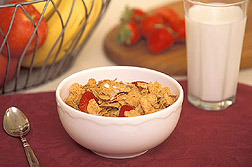
Some kinds of iron that today are added to your breakfast cereal are apparently less available than others for your body to absorb and use. That’s according to results from a preliminary study with laboratory rats. The experiment indicated that some forms of the iron were only 20 to 25 percent as “bioavailable” as ferrous sulfate, a highly bioavailable form of iron that scientists used as their yardstick. However, this more bioavailable form has its own disadvantages. For example, it can change the color and other qualities of food products. For the experiment, scientists at the ARS Grand Forks (N.D.) Human Nutrition Research Center teamed up with colleagues at a Washington, D.C.-based nutrition organization called SUSTAIN, short for “Sharing U.S. Technology to Aid in the Improvement of Nutrition.” The next step: A new study with female volunteers, to test two commonly used forms of powdered iron. Iron fortification is meant to help the 9 to 11 percent of American women and children who have iron deficiency or iron-deficiency anemia. For more information, contact Janet R. Hunt, (701) 795-8328, USDA-ARS Grand Forks Human Nutrition Research Center, Grand Forks, ND. Hunt for Hispanic Kids’ Obesity GenesHispanic children in the U.S. have among the highest levels of childhood obesity. 
A unique, 5-year investigation may identify genetic and environmental factors that contribute to childhood-onset obesity among young Hispanics. ARS-funded scientists at the Children’s Nutrition Research Center at Baylor College of Medicine, Houston, Texas, are conducting the study. In-depth testing of volunteer children and their parents includes exercise tests for the kids and interviews with dieticians, during which the youngsters describe the kinds and amounts of foods that they typically eat. Measurements also cover kids’ and parents’ weight, height, blood pressure, and body composition--that is, the ratio of body fat to muscle, bone, and water. All volunteers’ blood samples undergo genetic analysis by collaborators at the Southwest Foundation for Biomedical Research, San Antonio. One year after the first evaluations, scientists will again measure the youngsters, to determine if changes in these measurements are linked to the childrens’ genetic profiles. For more information, contact Nancy F. Butte, (713) 798-7179, USDA-ARS Children’s Nutrition Research Center at Baylor College of Medicine, Houston, TX. Hispanic Elders Can Dodge B12 DeficiencyElderly Hispanics who take nutritional supplements with B12 or who eat B12-fortified breakfast cereal more than four times a week may be significantly less likely to have low levels of this essential nutrient. Symptoms of B12 deficiency include loss of sensation, balance, and memory. This finding emerged from a study by scientists at the ARS Jean Mayer USDA Human Nutrition Research Center on Aging at Tufts University, Boston, Mass. Participants were 449 Hispanics from Puerto Rico and the Dominican Republic, and 154 non-Hispanic whites living in Massachusetts. Volunteers ranged in age from 60 to 93 years. The researchers reported in the Journal of Nutrition (December 2002, vol. 132, pages 2059-2064) that the Hispanic volunteers were significantly more likely to be vitamin B12-deficient than were the non-Hispanic white participants. For more information, contact Katherine L. Tucker, (617) 556-3351, ARS Jean Meyer USDA Human Nutrition Research Center on Aging at Tufts University, Boston, MA. Putting Meat on Our Bones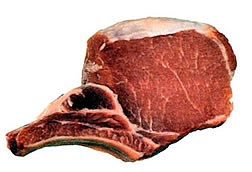
Contrary to some theories, eating several portions of meat every day may not deplete your body’s calcium supplies. A 16-week ARS study yielded this finding. The investigation probed the effects of meat protein on the amount of calcium retained by the 15 healthy, postmenopausal women who volunteered for the research. Even when eating only half the recommended dietary intake of calcium–a practice common among American women--the volunteers could eat twice the recommended dietary allowance of protein, mostly as meat, and still not have an adverse effect on calcium retention (April 2003, Journal of Nutrition, vol. 133, p. 1020-1026). A follow-up study should provide another close-up look at the interaction of calcium, protein, and healthy bones. In brief, volunteers will complete regimens in which the amount of calcium that they eat--whether low or high--will remain the same, but the amount of protein will vary, from a low-protein regimen to a higher one, or the reverse. The purpose? Re-investigate findings from research elsewhere which had suggested that high-protein meals plus ample daily calcium may benefit bone density. For more information, contact Zamzam (Fariba) Roughead, (701) 795-8463, USDA-ARS Grand Forks Human Nutrition Research Center, Grand Forks, ND. Health Gains From an Old Favorite–Barley!Barley not only adds a pleasing, nutlike flavor to soups, stews, breakfast foods and baked goods, it also has been newly shown to offer important health benefits. Preliminary results of two separate, 17-week studies--one with 18 men aged 35 to 62 and another with 20 women aged 35 to 55--are delineating the important properties of this grain. Scientists at the Beltsville (Md.) Human Nutrition Research Center are conducting the investigations. 
Researchers were interested in determining if barley, which contains digestible (soluble) fiber similar to that in oats, would have oats’ cholesterol-reducing benefits in healthy volunteers. The men and women participating in the research had moderately high cholesterol levels. They ate meals, prepared by the Center’s staff, that were lower in fat and higher in fiber than meals typically eaten by Americans. Within that framework, the meal plans varied in the total amount of soluble fiber provided from barley or other grains. On average, total cholesterol was lowered by as much as 21 percent in men who ate the meals highest in soluble fiber. Even men who ate the meals with the least amount of soluble fiber saw a 14 percent reduction in total cholesterol, on average. Analysis of findings from the female volunteers indicated that results were more pronounced in post-menopausal women than pre-menopausal women. Other early results showed that glucose and insulin levels, risk factors in type 2 diabetes, were lowered by the regimens that were highest in soluble fiber. For more information, contact Kay M. Behall, (301) 504-8682, USDA-ARS Beltsville Human Nutrition Research Center, Beltsville, MD. Fishing for Genetic Clues to Meatier Trout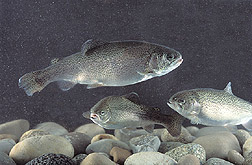
Some trout are better and faster than others at converting their feed into the tender, delicately flavored "meat," or muscle, that we eat. Soon, rainbow trout breeders may be able to more easily single out trout that have the genetic makeup to quickly develop less fat and more muscle. That’s the aim of new investigations by ARS scientists and their university colleagues at the Hagerman (Idaho) Fish Culture Experiment Station. Their new RT-PCR assay, short for "real-time polymerase chain reaction," reveals genetic activity that enables fish to produce a protein called myosin. Researchers have known of the correlation between myosin and muscle growth for decades. But the ARS and University of Idaho investigators are the first to use that correlation as the basis for a fast, reliable lab test of trout muscle growth. Test results should help breeders and researchers pinpoint fish that are best suited to serve as brood stock--the parents of new generations of premium, farm-raised trout. The RT-PCR test will also help the scientists profile the genetic makeup of fast-growing trout that muscle-up rapidly on environmentally friendly, grain-based feeds. The experimental feeds that the researchers are formulating are made, in part, of oats or barley. Faster-growing fish with a hearty appetite for grain could help fish ranchers meet the growing demand for farm-raised fish. And, using grain-based feeds should lessen the risk of overfishing oceanic species, such as jack mackerel or menhaden, that otherwise are used for fishmeal in feeds for their on-farm cousins. For more information, contact Kenneth E. Overturf, (208) 837-9096), USDA-ARS Small Grains and Potato Research Unit, Hagerman, ID. New Romaine Lettuces Resist Dieback DiseaseCrisp, crunchy romaine lettuce is perfect for a Caesar salad or for mixing with other fresh-salad greens. 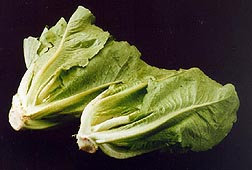
Now an ARS team at the U.S. Agricultural Research Station, Salinas, Calif., has developed what are apparently the first romaine lettuces that resist attack by the Tombusviruses that cause lettuce dieback disease. These soil-dwelling viruses don’t appear to affect crisphead--also known as iceberg--lettuce, or certain leaf lettuces. But the virus-caused dieback disease can wipe out entire fields of romaine. The investigators tested the lettuces--identified as 01-778M, 01-781M and 01-789M--for 3 years in both infested and disease-free fields at Salinas and two other coastal California sites. This spring, the scientists offered seed of the new lettuces to plant researchers and breeders who may try growing them in other locations, as well. For more information, contact Rebecca C. Grube, (831) 755-2862, U.S. Agricultural Research Station, Salinas, CA. Sierra--A New, Improved Garbanzo BeanA tasty new garbanzo bean--or chickpea--called Sierra could be coming to salad bars soon. Agricultural Research Service scientists and their cooperators developed Sierra. A kabuli-type chickpea, it’s perfect for salads and ethnic dishes. Besides their creamy taste, garbanzo beans offer a low-fat source of fiber; protein; iron; and vitamins A, C, and a B vitamin, folate. Sierra was derived by crossing Dwelley, another ARS-develop chickpea, with chickpeas obtained from Mexico and central Asia. Tested in Washington, Idaho, California, North Dakota, and South Dakota, Sierra offers high yields and is resistant to certain strains of Ascochtya blight, a fungal disease of chickpea. This spring marks the first commercial production of Sierra. ARS has filed for a plant variety protection certificate for the new chickpea. For more information, contact Frederick J. Muehlbauer, (509) 335-9521, USDA- ARS Grain Legume Genetics and Physiology Research Unit, Pullman, WA. |
|
The United States Department of Agriculture (USDA) prohibits discrimination in all its programs and activities on the basis of race, color, national origin, gender, religion, age, disability, political beliefs, sexual orientation, and marital or family status. (Not all prohibited bases apply to all programs.) Persons with disabilities who require alternative means for communication of program information (Braille, large print, audiotape, etc.) should contact USDA's TARGET Center at 202-720-2600 (voice and TDD). To file a complaint of discrimination, write USDA, Director, Office of Civil Rights, Room 326-W, Whitten Building, 14th and Independence Ave., SW, Washington, DC 20250-9410 or call 202-720-5964 (voice or TDD). USDA is an equal opportunity provider and employer. |

